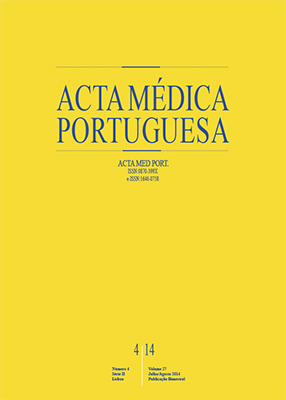Transobturator Slings for Female Stress Urinary Incontinence
DOI:
https://doi.org/10.20344/amp.4869Abstract
Introduction: Stress urinary incontinence affects about 20- 40% of women. Treatment with transobturator mid-urethral slings is consensually accepted nowadays. The goal of this study was to evaluate the success rate and most frequent complications of surgical treatment with transobturator mid- urethral slings in stress urinary incontinence.
Material and Methods: This study evaluated 363 patients who underwent correction of stress urinary incontinence with a transobturator tape in Hospitais da Universidade de Coimbra between January 1st 2008 and July 1st 2010.
Results: The mean age of patients was 56 [28-86]. In 13.5% of women, the correction of stress urinary incontinence was associated with other vaginal surgery. The majority of these women (95.3%) had urethral hypermobility. Only 0.8% of women suffered of perioperative complications, 5.2% of immediate postoperative complications and 15.7% of late postoperative complications. The global success rate was 93.7%. The success rate in patients with fixed urethra was lower (77.8%) comparing with the results of those with urethral hypermobility, being successful in 94.5% (p = 0.02). The success rate was similar in patients with or without vaginal surgeries.
Discussion: Treatment with transobturator mid-urethral slings has high success rates and it became the first treatment chosen to stress urinary incontinence, even if they were treated with the technique outside-in (TOT®) or inside-out (TVT-O®). Both techniques were conceived to avoid passing through the retropubic space, decreasing the complicate matters number.
Conclusions: The cure rates for the transobturator surgical approach range between 80 and 95%. The cure rate increases when the mechanism responsible for the urinary incontinence is urethral hypermobility, although it is not modified when are performed other vaginal surgeries concomitantly.
Keywords: Urinary Incontinence, Stress; Suburethral Slings.
Downloads
Downloads
Published
How to Cite
Issue
Section
License
All the articles published in the AMP are open access and comply with the requirements of funding agencies or academic institutions. The AMP is governed by the terms of the Creative Commons ‘Attribution – Non-Commercial Use - (CC-BY-NC)’ license, regarding the use by third parties.
It is the author’s responsibility to obtain approval for the reproduction of figures, tables, etc. from other publications.
Upon acceptance of an article for publication, the authors will be asked to complete the ICMJE “Copyright Liability and Copyright Sharing Statement “(http://www.actamedicaportuguesa.com/info/AMP-NormasPublicacao.pdf) and the “Declaration of Potential Conflicts of Interest” (http:// www.icmje.org/conflicts-of-interest). An e-mail will be sent to the corresponding author to acknowledge receipt of the manuscript.
After publication, the authors are authorised to make their articles available in repositories of their institutions of origin, as long as they always mention where they were published and according to the Creative Commons license.









